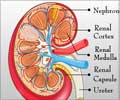Dialysis led to around 1.23 million deaths in 2017. Rates of people requiring dialysis have raised 40% since 1990, but access still inequitable. Health systems cant keep pace with demand for dialysis.

‘Proper preventive care and public health policy are the need of the hour for patients with diabetes and hypertension, as diabetes and hypertension are primary causes of chronic kidney disease.’
Read More..




Globally, chronic kidney disease directly resulted in an estimated 1.23 million deaths in 2017, with an additional 1.36 million deaths attributable to cardiovascular disease resulting from impaired kidney function. Read More..
Chronic kidney disease was the 12th leading cause of death globally in 2017, up from 17th in 1990.
There were 697.5 million cases of chronic kidney disease in 2017. Nearly one-third of those patients lived in two countries - China, with about 132 million cases, and India, with about 115 million.
Further, 10 other nations - the US, Indonesia, Russia, Japan, Brazil, Pakistan, Mexico, Nigeria, Bangladesh, and Vietnam - each had more than 10 million cases in 2017. In total, 79 of the 195 countries included in the study exceeded 1 million cases.
Those cases and deaths in 2017 led to an estimated 7.3 million years lived with disability and 28.5 million years of life lost, according to the study.
Advertisement
The primary cause of chronic kidney disease varies, with hypertension and diabetes being the most common. The link between kidney disease and other major non-communicable diseases highlights the importance of preventive care and public health policy in limiting the progression of chronic kidney disease.
Advertisement
The study, published in the international medical journal The Lancet, is part of the annual Global Burden of Disease study, the world’s largest and most comprehensive effort to quantify health loss. The next edition of the study will be published in May in collaboration with the World Health Organization.
Among other findings:
The burden of chronic kidney disease is studied predominantly in high-income countries, in terms of prevalence, quality of life, death, and kidney and cardiovascular complications.
Even where results of large-scale national kidney disease screening programs are available, many data sources report estimates only for selected populations limited by age group, geography, and occupation, among other factors.
For many regions of the world with high chronic kidney disease burden, such as Central America, Latin America, and Oceania, there are few or no data on chronic kidney disease. In these cases, computer modeling was used to develop health estimates.
Source-Eurekalert










